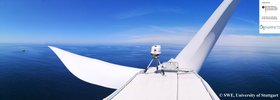Generating green energy from the sea
TU researchers measure environmental impact on wind turbines
26.10.2022

In view of the current energy crisis, the generation of green hydrogen is becoming increasingly relevant. This simultaneously increases the demand for renewable energies, such as solar or wind energy. Researchers at the Technical University of Hamburg investigated the potential behind floating wind turbines. With their results, they were able to show that floating offshore wind turbines can be cost-efficient and thus competitive with other energy suppliers.
In wind and weather
During the six-month study at the French wind turbine FLOATGEN, the TU scientists∗ used sensors to determine different effects on the structure of the floating platform and evaluated possible risks on this basis. In doing so, they analyzed wave heights and periods, the speed of the currents in the water, and the wind speed in front of and behind the turbine rotor. "We were able to make statements about the loads and motion behavior of a floating offshore wind turbine under the influence of waves and show that the loads acting on it can be precisely predicted under real conditions," says scientist Christian Schulz of the TU Institute of Fluid Dynamics and Ship Theory. In this way, Schulz and his colleagues were able to develop proposals for the simulation and control of the wind turbine in order to optimize the turbine's dynamics and reduce the aerodynamic loads on the rotor and thus on the platform. "This paves the way for us to efficiently generate green hydrogen from the sea," the TU expert said.
In addition to TU Hamburg, six other partners were involved in the Franco-German project: the Chair of Wind Energy (SWE) at the University of Stuttgart, the Research Laboratory for Hydrodynamics, Energetics and Atmospheric Environment at the Ecole Centrale de Nantes (ECN), sowento GmbH, and GL Garrad Hassan Deutschland GmbH, UL International GmbH and BW Ideol S.A.as associated partners.
TUHH - Public Relations Office







